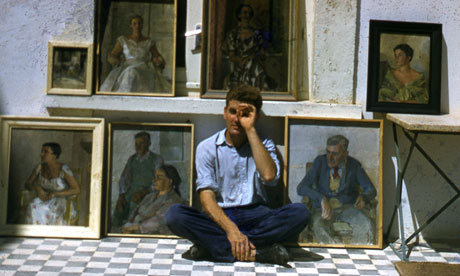
The artist, scholar and teacher Christopher Pemberton, who has died aged 87, brought a penetrating intelligence and humility to his work. At the Camberwell School of Art, south London, he found something of these qualities in his teacher William Coldstream's practice of measuring with brush held up at arm's length to find equal and multiple distances across his subject. This provided a sort of ground bass or continuo accompanying the accrual of marks and colours on the canvas. Chris's eye and hand had no need of this measuring aid, but humility in front of the subject became integral to his approach. He exhibited at the Royal Academy, central London, in the 1950s, and various shows elsewhere included eight one-man presentations, two of them at the Cadogan Contemporary gallery in South Kensington.
Coldstream's last year at Camberwell (1948-49), before he became professor at the Slade School of Art, University of London, overlapped with Chris's first as a student. The fine art department at Camberwell was in effect a continuation of the Euston Road school of artists, a group dedicated to working directly from nature and associated with the establishment at 314 Euston Road, in central London (1937-39). Of the Euston Road painters, Claude Rogers had the most natural gift for the act of painting directly from the subject without auxiliary consideration, and came to have more to offer Chris. A Pemberton painting of 1950, of a street scene in Chelsea, displays exacting and convincing appraisal of sizes, distances and tones, a "Euston Road" work certainly.
However, about 10 years later, when Chris was back at Camberwell as a teacher, one of his students, the painter Terry Raybould, was having difficulty in drawing a twist in the body of the model, and sought advice. Later Terry recalled his teacher's response: "He started a drawing next to mine on the paper. He worked at a steady pace to start with but gradually speeded up, then stopped and took off his jacket, started again building up the drawing in quick spurts – dots and quick lines dashing about, stopped again, took off his sleeveless jumper to reveal braces, loosened his tie and off he went again! Gradually the marks accumulated to make a beautifully sensitive, knotty drawing of the figure. He then breathed an exasperated sigh and said 'Well, I can't do it either.'" The episode is recorded in Camberwell School of Arts & Crafts: Its Students and Teachers 1943-1960, by Geoff Hassell.
A landscape drawing done some 20 years later shows that Chris's vigorous personal appraisal of what is to be seen had matured into an even continuity of search, each quick touch of pencil an inquiry into what – and perhaps who – was in the precise spot to which his gesture was momentarily addressed.
Later, in 1991, his translation into English of Joachim Gasquet's Cézanne: A Memoir With Conversations was published. His translator's introduction reveals an astonishing understanding of both writer and subject. While other artists took up particular aspects of Cézanne's work, Pemberton had a fuller sense of the undivided whole of that master's reverence for the created world.
Chris was born in London. His father, Richard Pemberton, began his career as a clerk in the House of Lords, and subsequently became inspector of schools in Suffolk. His mother, Daphne, was artistically talented, and drew, painted and modelled in clay. He had a twin, Jeremy, and a younger brother, Roger. As a young boy he showed a gift as a draughtsman and did telling portrait drawings of his family.
At prep school he excelled in Latin and Greek and won a scholarship to Eton, where Wilfrid Blunt - a more genial and outgoing bachelor than his aloof art-historian brother Anthony - was art master. There Chris was much admired for painting a great mural of the meeting of Solomon and Sheba. He became captain of the school, and won a classical scholarship to Christ Church, Oxford.
However, the war intervened, and Chris served in the RNVR, accompanying Atlantic convoys in a corvette, in which he read Voltaire during the long nights. When the war was over, he read modern history at Christ Church, evidently supposing it would enhance his understanding of the times. In this he was disappointed, finding, it seems, that it was composed more of nominated events than the real continuum which is life. Nevertheless, he obtained a degree, and on holiday in Cyprus turned with relief to painting.
After leaving Camberwell, he taught at Bryanston school, Dorset, and subsequently at Shrewsbury school, Shropshire. In 1956 he married Hester Buchanan Riddell, a Russian scholar, and sister-in-law of his friend the historian Richard Ollard. When Chris returned to Camberwell, now as a teacher, they found a house east of Greenwich, where they brought up a family of four sons and a daughter.
In 1960, his brother Roger told him of the attractions of the Cotentin coast of Normandy, and subsequently holidays were spent there. Eventually he and Hester bought an old farmhouse near Fermanville, north-east of Cherbourg, where many friends were invited to visit.
He and Hester moved from London in 1983 to an old farmhouse at Bardwell, near Bury St Edmunds, Suffolk, and exhibitions in later years included the Chappel Galleries near Colchester, Essex, and the Highgate Gallery, north London.
Hester died in 2001, and Chris is survived by his children.
• Christopher Henry Pemberton, artist, scholar and teacher, born 14 March 1923; died 1 December 2010

